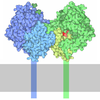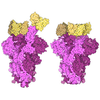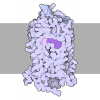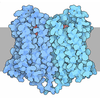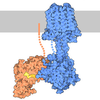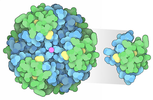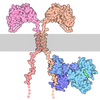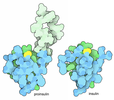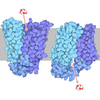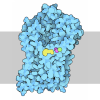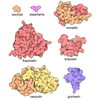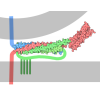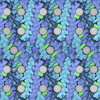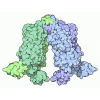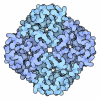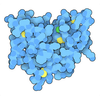+ データを開く
データを開く
- 基本情報
基本情報
| 登録情報 | データベース: PDB / ID: 7vla | ||||||
|---|---|---|---|---|---|---|---|
| タイトル | Cryo-EM structure of the CCL15(27-92) bound CCR1-Gi complex | ||||||
 要素 要素 |
| ||||||
 キーワード キーワード | MEMBRANE PROTEIN / GPCR / CCR1 / Chemokine Receptor / MEMBRNE PROTEIN | ||||||
| 機能・相同性 |  機能・相同性情報 機能・相同性情報chemokine (C-C motif) ligand 7 binding / chemokine (C-C motif) ligand 5 binding / chemokine receptor activity / CCR chemokine receptor binding / negative regulation of bone mineralization / phosphatidylinositol-4,5-bisphosphate phospholipase C activity / C-C chemokine receptor activity / chemokine-mediated signaling pathway / C-C chemokine binding / positive regulation of calcium ion transport ...chemokine (C-C motif) ligand 7 binding / chemokine (C-C motif) ligand 5 binding / chemokine receptor activity / CCR chemokine receptor binding / negative regulation of bone mineralization / phosphatidylinositol-4,5-bisphosphate phospholipase C activity / C-C chemokine receptor activity / chemokine-mediated signaling pathway / C-C chemokine binding / positive regulation of calcium ion transport / positive regulation of osteoclast differentiation / positive regulation of monocyte chemotaxis / chemokine activity / Chemokine receptors bind chemokines / dendritic cell chemotaxis / chemoattractant activity / Interleukin-10 signaling / monocyte chemotaxis / exocytosis / G protein-coupled receptor signaling pathway, coupled to cyclic nucleotide second messenger / adenylate cyclase inhibitor activity / positive regulation of protein localization to cell cortex / Adenylate cyclase inhibitory pathway / T cell migration / D2 dopamine receptor binding / response to prostaglandin E / adenylate cyclase regulator activity / G protein-coupled serotonin receptor binding / adenylate cyclase-inhibiting serotonin receptor signaling pathway / cellular response to forskolin / regulation of mitotic spindle organization / cell chemotaxis / Regulation of insulin secretion / positive regulation of cholesterol biosynthetic process / calcium-mediated signaling / negative regulation of insulin secretion / G protein-coupled receptor binding / response to peptide hormone / adenylate cyclase-inhibiting G protein-coupled receptor signaling pathway / adenylate cyclase-modulating G protein-coupled receptor signaling pathway / response to wounding / G-protein beta/gamma-subunit complex binding / centriolar satellite / Olfactory Signaling Pathway / Activation of the phototransduction cascade / G beta:gamma signalling through PLC beta / Presynaptic function of Kainate receptors / Thromboxane signalling through TP receptor / G protein-coupled acetylcholine receptor signaling pathway / G-protein activation / Activation of G protein gated Potassium channels / Inhibition of voltage gated Ca2+ channels via Gbeta/gamma subunits / Prostacyclin signalling through prostacyclin receptor / G beta:gamma signalling through CDC42 / cytokine-mediated signaling pathway / intracellular calcium ion homeostasis / chemotaxis / Glucagon signaling in metabolic regulation / G beta:gamma signalling through BTK / Synthesis, secretion, and inactivation of Glucagon-like Peptide-1 (GLP-1) / ADP signalling through P2Y purinoceptor 12 / photoreceptor disc membrane / antimicrobial humoral immune response mediated by antimicrobial peptide / Sensory perception of sweet, bitter, and umami (glutamate) taste / Glucagon-type ligand receptors / Adrenaline,noradrenaline inhibits insulin secretion / Vasopressin regulates renal water homeostasis via Aquaporins / GDP binding / Glucagon-like Peptide-1 (GLP1) regulates insulin secretion / G alpha (z) signalling events / calcium ion transport / cellular response to catecholamine stimulus / ADP signalling through P2Y purinoceptor 1 / ADORA2B mediated anti-inflammatory cytokines production / G beta:gamma signalling through PI3Kgamma / Cooperation of PDCL (PhLP1) and TRiC/CCT in G-protein beta folding / adenylate cyclase-activating dopamine receptor signaling pathway / GPER1 signaling / Inactivation, recovery and regulation of the phototransduction cascade / cellular response to prostaglandin E stimulus / G-protein beta-subunit binding / heterotrimeric G-protein complex / cell-cell signaling / G alpha (12/13) signalling events / sensory perception of taste / extracellular vesicle / heparin binding / signaling receptor complex adaptor activity / Thrombin signalling through proteinase activated receptors (PARs) / retina development in camera-type eye / G protein activity / positive regulation of cytosolic calcium ion concentration / GTPase binding / Ca2+ pathway / fibroblast proliferation / midbody / High laminar flow shear stress activates signaling by PIEZO1 and PECAM1:CDH5:KDR in endothelial cells / cell cortex / G alpha (i) signalling events / G alpha (s) signalling events 類似検索 - 分子機能 | ||||||
| 生物種 |  Homo sapiens (ヒト) Homo sapiens (ヒト) | ||||||
| 手法 | 電子顕微鏡法 / 単粒子再構成法 / クライオ電子顕微鏡法 / 解像度: 2.7 Å | ||||||
 データ登録者 データ登録者 | Shao, Z. / Shen, Q. / Mao, C. / Yao, B. / Chen, L. / Zhang, H. / Shen, D. / Zhang, C. / Li, W. / Du, X. ...Shao, Z. / Shen, Q. / Mao, C. / Yao, B. / Chen, L. / Zhang, H. / Shen, D. / Zhang, C. / Li, W. / Du, X. / Li, F. / Ma, H. / Chen, Z. / Xu, H.E. / Ying, S. / Zhang, Y. / Shen, H. | ||||||
| 資金援助 |  中国, 1件 中国, 1件
| ||||||
 引用 引用 |  ジャーナル: Nat Chem Biol / 年: 2022 ジャーナル: Nat Chem Biol / 年: 2022タイトル: Identification and mechanism of G protein-biased ligands for chemokine receptor CCR1. 著者: Zhehua Shao / Qingya Shen / Bingpeng Yao / Chunyou Mao / Li-Nan Chen / Huibing Zhang / Dan-Dan Shen / Chao Zhang / Weijie Li / Xufei Du / Fei Li / Honglei Ma / Zhi-Hua Chen / H Eric Xu / ...著者: Zhehua Shao / Qingya Shen / Bingpeng Yao / Chunyou Mao / Li-Nan Chen / Huibing Zhang / Dan-Dan Shen / Chao Zhang / Weijie Li / Xufei Du / Fei Li / Honglei Ma / Zhi-Hua Chen / H Eric Xu / Songmin Ying / Yan Zhang / Huahao Shen /  要旨: Biased signaling of G protein-coupled receptors describes an ability of different ligands that preferentially activate an alternative downstream signaling pathway. In this work, we identified and ...Biased signaling of G protein-coupled receptors describes an ability of different ligands that preferentially activate an alternative downstream signaling pathway. In this work, we identified and characterized different N-terminal truncations of endogenous chemokine CCL15 as balanced or biased agonists targeting CCR1, and presented three cryogenic-electron microscopy structures of the CCR1-G complex in the ligand-free form or bound to different CCL15 truncations with a resolution of 2.6-2.9 Å, illustrating the structural basis of natural biased signaling that initiates an inflammation response. Complemented with pharmacological and computational studies, these structures revealed it was the conformational change of Tyr291 (Y291) in CCR1 that triggered its polar network rearrangement in the orthosteric binding pocket and allosterically regulated the activation of β-arrestin signaling. Our structure of CCL15-bound CCR1 also exhibited a critical site for ligand binding distinct from many other chemokine-receptor complexes, providing new insights into the mode of chemokine recognition. | ||||||
| 履歴 |
|
- 構造の表示
構造の表示
| 構造ビューア | 分子:  Molmil Molmil Jmol/JSmol Jmol/JSmol |
|---|
- ダウンロードとリンク
ダウンロードとリンク
- ダウンロード
ダウンロード
| PDBx/mmCIF形式 |  7vla.cif.gz 7vla.cif.gz | 237 KB | 表示 |  PDBx/mmCIF形式 PDBx/mmCIF形式 |
|---|---|---|---|---|
| PDB形式 |  pdb7vla.ent.gz pdb7vla.ent.gz | 177.3 KB | 表示 |  PDB形式 PDB形式 |
| PDBx/mmJSON形式 |  7vla.json.gz 7vla.json.gz | ツリー表示 |  PDBx/mmJSON形式 PDBx/mmJSON形式 | |
| その他 |  その他のダウンロード その他のダウンロード |
-検証レポート
| 文書・要旨 |  7vla_validation.pdf.gz 7vla_validation.pdf.gz | 859.3 KB | 表示 |  wwPDB検証レポート wwPDB検証レポート |
|---|---|---|---|---|
| 文書・詳細版 |  7vla_full_validation.pdf.gz 7vla_full_validation.pdf.gz | 875.1 KB | 表示 | |
| XML形式データ |  7vla_validation.xml.gz 7vla_validation.xml.gz | 36.5 KB | 表示 | |
| CIF形式データ |  7vla_validation.cif.gz 7vla_validation.cif.gz | 57.7 KB | 表示 | |
| アーカイブディレクトリ |  https://data.pdbj.org/pub/pdb/validation_reports/vl/7vla https://data.pdbj.org/pub/pdb/validation_reports/vl/7vla ftp://data.pdbj.org/pub/pdb/validation_reports/vl/7vla ftp://data.pdbj.org/pub/pdb/validation_reports/vl/7vla | HTTPS FTP |
-関連構造データ
| 関連構造データ |  32022MC  7vl8C  7vl9C M: このデータのモデリングに利用したマップデータ C: 同じ文献を引用 ( |
|---|---|
| 類似構造データ | 類似検索 - 機能・相同性  F&H 検索 F&H 検索 |
- リンク
リンク
- 集合体
集合体
| 登録構造単位 | 
|
|---|---|
| 1 |
|
- 要素
要素
-Guanine nucleotide-binding protein ... , 3種, 3分子 ABG
| #1: タンパク質 | 分子量: 40414.047 Da / 分子数: 1 / 由来タイプ: 組換発現 / 由来: (組換発現)  Homo sapiens (ヒト) / 遺伝子: GNAI1 / Cell (発現宿主): SF9 Homo sapiens (ヒト) / 遺伝子: GNAI1 / Cell (発現宿主): SF9発現宿主:  参照: UniProt: P63096 |
|---|---|
| #2: タンパク質 | 分子量: 37728.152 Da / 分子数: 1 / 由来タイプ: 組換発現 / 由来: (組換発現)  Homo sapiens (ヒト) / 遺伝子: GNB1 Homo sapiens (ヒト) / 遺伝子: GNB1発現宿主:  参照: UniProt: P62873 |
| #3: タンパク質 | 分子量: 7861.143 Da / 分子数: 1 / 由来タイプ: 組換発現 / 由来: (組換発現)  Homo sapiens (ヒト) / 遺伝子: GNG2 / Cell (発現宿主): SF9 Homo sapiens (ヒト) / 遺伝子: GNG2 / Cell (発現宿主): SF9発現宿主:  参照: UniProt: P59768 |
-タンパク質 , 2種, 2分子 LR
| #4: タンパク質 | 分子量: 8218.506 Da / 分子数: 1 / 由来タイプ: 組換発現 / 由来: (組換発現)  Homo sapiens (ヒト) / 遺伝子: CCL15, MIP5, NCC3, SCYA15 Homo sapiens (ヒト) / 遺伝子: CCL15, MIP5, NCC3, SCYA15発現宿主:  参照: UniProt: Q16663 |
|---|---|
| #5: タンパク質 | 分子量: 42203.547 Da / 分子数: 1 / 由来タイプ: 組換発現 / 由来: (組換発現)  Homo sapiens (ヒト) / 遺伝子: CCR1, CMKBR1, CMKR1, SCYAR1 Homo sapiens (ヒト) / 遺伝子: CCR1, CMKBR1, CMKR1, SCYAR1発現宿主:  参照: UniProt: P32246 |
-抗体 / 非ポリマー , 2種, 2分子 S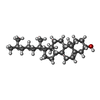

| #6: 抗体 | 分子量: 27340.482 Da / 分子数: 1 / 由来タイプ: 組換発現 / 由来: (組換発現)  Homo sapiens (ヒト) Homo sapiens (ヒト)発現宿主:  |
|---|---|
| #7: 化合物 | ChemComp-CLR / |
-詳細
| 研究の焦点であるリガンドがあるか | Y |
|---|---|
| Has protein modification | Y |
-実験情報
-実験
| 実験 | 手法: 電子顕微鏡法 |
|---|---|
| EM実験 | 試料の集合状態: PARTICLE / 3次元再構成法: 単粒子再構成法 |
- 試料調製
試料調製
| 構成要素 | 名称: CCL15(27-92)-bound CCR1-Gi complex / タイプ: COMPLEX / Entity ID: #1-#6 / 由来: RECOMBINANT |
|---|---|
| 由来(天然) | 生物種:  Homo sapiens (ヒト) Homo sapiens (ヒト) |
| 由来(組換発現) | 生物種:  |
| 緩衝液 | pH: 7.5 |
| 試料 | 包埋: NO / シャドウイング: NO / 染色: NO / 凍結: YES |
| 急速凍結 | 装置: FEI VITROBOT MARK IV / 凍結剤: ETHANE |
- 電子顕微鏡撮影
電子顕微鏡撮影
| 実験機器 |  モデル: Titan Krios / 画像提供: FEI Company |
|---|---|
| 顕微鏡 | モデル: FEI TITAN KRIOS |
| 電子銃 | 電子線源:  FIELD EMISSION GUN / 加速電圧: 300 kV / 照射モード: FLOOD BEAM FIELD EMISSION GUN / 加速電圧: 300 kV / 照射モード: FLOOD BEAM |
| 電子レンズ | モード: BRIGHT FIELD |
| 撮影 | 電子線照射量: 62 e/Å2 / 検出モード: COUNTING フィルム・検出器のモデル: GATAN K2 SUMMIT (4k x 4k) |
- 解析
解析
| ソフトウェア |
| ||||||||||||||||||||||||
|---|---|---|---|---|---|---|---|---|---|---|---|---|---|---|---|---|---|---|---|---|---|---|---|---|---|
| EMソフトウェア |
| ||||||||||||||||||||||||
| CTF補正 | タイプ: PHASE FLIPPING AND AMPLITUDE CORRECTION | ||||||||||||||||||||||||
| 3次元再構成 | 解像度: 2.7 Å / 解像度の算出法: FSC 0.143 CUT-OFF / 粒子像の数: 423872 / 対称性のタイプ: POINT | ||||||||||||||||||||||||
| 原子モデル構築 | プロトコル: FLEXIBLE FIT / 空間: REAL | ||||||||||||||||||||||||
| 原子モデル構築 | PDB-ID: 6DO1 Accession code: 6DO1 / Source name: PDB / タイプ: experimental model | ||||||||||||||||||||||||
| 精密化 | 交差検証法: NONE 立体化学のターゲット値: GeoStd + Monomer Library + CDL v1.2 | ||||||||||||||||||||||||
| 原子変位パラメータ | Biso mean: 39.9 Å2 | ||||||||||||||||||||||||
| 拘束条件 |
|
 ムービー
ムービー コントローラー
コントローラー





 PDBj
PDBj